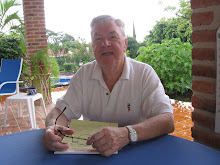The True Meaning of Christmas. (832 words)
By John de Waal.
Do you ever wonder why you so look forward to Christmas, why your pulse quickens when you see the stores being made ready for the season? Is it your childhood memories: of a Christmas tree decorated with little goats, angles, baubles, strings and candles; of the whole family around the Christmas dinner table or you’re wondering which of those colorful packages beneath the tree would be yours? Perhaps you remember your own children’s glowing faces and the warm feeling of togetherness, or is it something else, like the feeling of being loved and protected?
Yes, Christmas will do that to you and you are not alone in that. That’s why the holiday is celebrated by 96% of all Americans, Christians and non-Christians alike, and the percentage is probably higher among Mexicans. While not quite the same situation here at Lakeside as up north, the days are getting shorter and shorter, the weather downright nasty and the sun makes only rare appearances. The denuded trees are grasping at the sky with bare branches. Everything takes on a somber look. And that’s the reason why this day is so important to us. It is something ingrained in the human body and mind. For years, people suspected that there was a psychological effect of this time of year, but now we know that it is also physiological. It is the reaction of the body and the mind to the low light levels. All living creatures crave light and we’re no different. That’s why the beckoning stores draw us in like a moth to the flame of a candle.
As we moved further away from our tropical birthplace, the impacts of loss of light became more and more noticeable and we had no choice but to weave the "rebirth of the sun" into our social, cultural and religious fabric, as well as into our species' biology. So, we have been celebrating the Winter Solstice for a long time before Christianity came along. And this is as true for the ancient Egyptians, Babylonians and Persians, the Romans, the Norse, the Germans and the Celts, the Pakistanis, the Tibetans, the Chinese, and the Japanese, even the Native North Americans.
At the root of all these celebrations and rituals is the battle between Light and Dark. As Light wins, it drives away the gloom and raises our spirits. And even though Christmas seems a religious feast, it is that only nominally. Just consider the facts:
Christmas, Christ's Mass, Christmas Day or Christmastide, one of the most globally recognized midwinter celebrations is celebrated on December 25 to ostensibly mark the birth of Jesus of Nazareth, even though it is not Jesus' actual date of birth, but December 25 is Winter Solstice, the day when the gradually lengthening nights and shortening days in the northern hemisphere reverse. It was (and is) interpreted as the rebirth of nature, another year of life!
• So, in addition to the Church imposed rituals that include nativity scenes and pageants, in its continuing quest to remind the laity of God’s magnanimity
We celebrate with:
• Good deeds and gift giving in the tradition of St. Nicholas, i.e. by not admitting to being the actual gift giver. This is also observed in many other countries.
In the US it was not long before commercial interests recognized the potential of this gift-giving tradition and so we have Santa Claus or Father Christmas, who is a combination of the Bishop of Myra and elements from pagan Nordic mythology. Santa was first immortalized by illustrator Thomas Nast at the cover of the January 3, 1863 issue of Harper's Weekly, the Journal of Civilizatio, during the height of the uncivilized American Civil War. Then he was commercially utilized by the Coca Cola Company and other enterprises.
• The Christmas tree. This symbol was “invented” in 723 by the Anglo-Saxon missionary St Boniface. He felled the Thor Tree, a huge oak believed to be the home of the God Thor (he made a chapel from its wood), in his quest to convert the northern Germanic tribes to Christianity.
• Lights. Celebratory lighting at the time of winter festivals also predates Christianity and the use of organized illuminations as semi-public entertainment can be traced to the Ancient Chinese.
• Mistletoe. When Norse goddess Frigga’s son was killed by an arrow made of mistletoe by an evil spirit, her tears of white berries brought him back to life. She blessed the plant and made it sacred. Mistletoe in your door will therefore protect you against evil and to kiss beneath it will bring you good luck.
• Holly, the sacred plant of Saturn, which was used as decoration at the Roman Saturnalia festivals on December 25th, another pagan custom.
Thus, virtually all elements that comprise Christmas predate Christianity and are pagan, while the date is a cosmological event that has been usurped by the Church of Rome. We are really celebrating Winter Solstice, but under a different name.
Thursday, November 13, 2008
Subscribe to:
Post Comments (Atom)

No comments:
Post a Comment